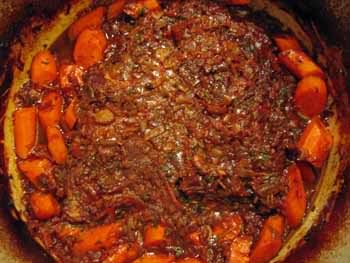
On the great, long list of Jewish dishes worth losing a kidney for—kasha varnishkes, matzoh balls, potato kugel, kishke—one stands head and shoulders above the rest: Brisket. The traditional main course for virtually any Jewish holiday, it’s a classic case of taking something of supposedly lesser quality—in this case, a tough cut of beef—and transforming it into something sublime, with strands of richly flavored meat lilting away at the mere suggestion of pressure from a fork. And the gravy! Plate-licking good, that stuff.
Brisket is a staple in my mother’s repertoire—it will be on the menu at both seders this weekend—but until now it had never occurred to me to make it myself. And then (there’s always an “and then” in these stories, isn’t there?) we decided to have our friend L over for dinner midweek. Normally such a thing isn’t an issue, and it wasn’t when we set the date, but last week I got called in for a full-time freelance job. I’m not sure why, but for some reason working regular hours, in an office, taxes me considerably. I come home exhausted from the commute, and the last thing on my mind is cooking. You may have noticed a lack of posts these last two weeks—this is why. When I’m too tired to cook, I’m also too tired to write. It’s all very silly, really. I worked a regular job for fifteen years, getting up at 6 to go to the gym beforehand and then going out for drinks or dinner after, or coming home and cooking. Millions of people the world over hold full-time jobs and put food on the table every night. But I’m somewhat spoiled by my freelance life, and it always takes me a while to adjust to the demands of a regular schedule.
So. Anyway. L was coming for dinner on Wednesday, and I knew I wouldn’t want to rush home and cook. Circumstances called for something that would benefit from being made ahead of time. There are very few dishes that love advance cooking more than brisket. When people talk about letting something sit so the flavors can meld, it’s brisket they’re thinking of. It’s just so deeeeeep, so mellow, so rewarding. I made it on Tuesday after work—see, I can find the energy when I need to! Here’s what it looked like when I pulled it from the oven:

(Bonus: I got to use Big Blue.)
It luxuriated in the fridge overnight. When I got home from work last night I cut up some potatoes and some asparagus to roast, and reheated the meat. While it cooked we nibbled on a little plate of marcona almonds, pappadew peppers, cheese, and figs, and sipped refreshing spritzers made with the Lorina pink lemonade brought by our guest.

And then it was time to eat. Oh, it was good! And so easy! Who knew? OK, the Jews knew.
Oh So Good Brisket
Adapted from Joan Nathan’s Jewish Cooking in America
Serves 6-8
2 t. salt
Freshly ground pepper
1 3 ½-lb brisket of beef
1 garlic clove, peeled and halved
2 T. vegetable oil
3 onions, peeled and diced
1 10-oz. can tomatoes [I use Pomi brand chopped tomatoes]
12 sun-dried tomatoes, roughly chopped
2 ½ cups red wine, divided
1 bay leaf
1 sprig fresh thyme
1 sprig fresh rosemary
¼ cup chopped parsley
5 carrots, peeled and sliced on the diagonal about ½” thick
½ cup apple juice
Preheat oven to 325.
Trim the excess fat from the meat. [NOTE: this is extremely non-traditional. Most recipes expressly forbid it, and in fact I called my mother in a panic after I’d done it out of habit. She thought things might turn out ok anyway, and sure enough they did, so I’m making it an official part of the recipe.]
Sprinkle the salt and pepper all over the brisket, and rub with the cut sides of the garlic halves. Heat the oil over medium-high heat in a large ovenproof casserole or Dutch oven, and sear the brisket on both sides. Remove the brisket and throw in the onions, then place the brisket on top. Add the tomatoes, sun-dried tomatoes, 2 cups of the wine, bay leaf, thyme, and rosemary.
Cover and bake for about 3 hours, basting every half-hour or so with the pan juices.
Add the parsley and carrots (submerge the carrots in the braising liquid) and bake, covered, for about fifteen minutes, then remove the cover and bake for another fifteen, or until the carrots are cooked. To test for doneness, stick a fork in the flat (thinner end) of the brisket. When there is a light pull on the fork as it is removed from the meat, it is “fork tender.”
If you’re like me, by now all your liquid has cooked out of the pot, and you’re wondering where on earth all this fabled gravy is supposed to come from. Fear not! Here’s what to do:
Remove the meat and the carrots from the pot and set aside. Scoop out the soft, well-cooked onions and tomatoes and place them in a blender. Blend thoroughly (be careful when blending hot liquids—make sure the cover’s on tight), adding some of the reserved wine if it still looks too thick.
When the meat is cool, slice it against the grain and put it in a storage container, along with the carrots. Pour the gravy over. Refrigerate overnight.
The next day, remove the meat and carrots from the container, and pour the gravy into a pan large enough to eventually hold everything. If it looks too thick, add some more red wine and apple juice, a splash at a time, until it is the desired consistency. Let it simmer for a few minutes, to give the flavors a chance to mellow. Adjust salt & pepper if necessary. Add the meat and carrots to the pan, cover, and reheat over a low flame.